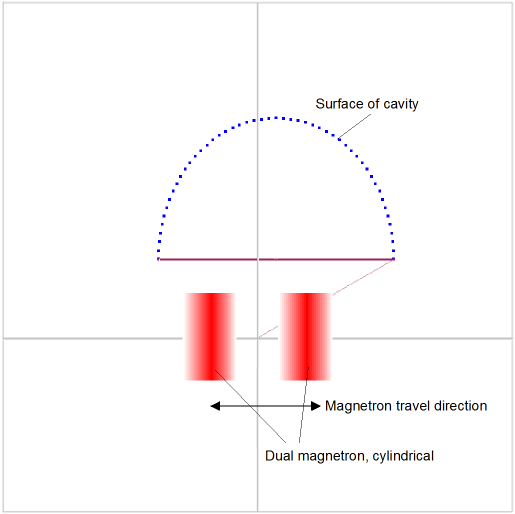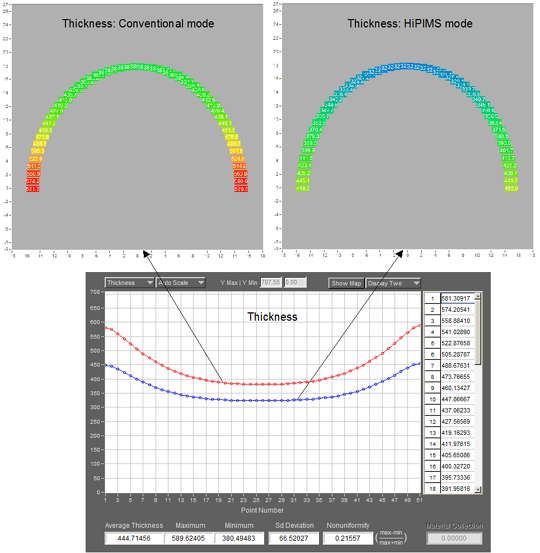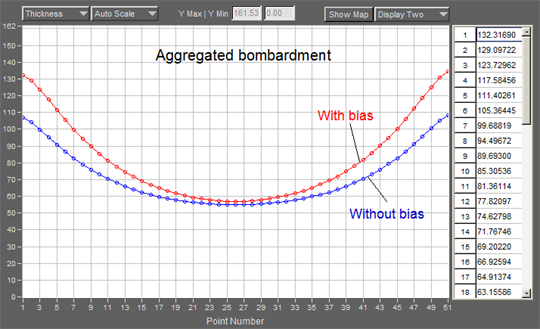Newsletter issued in October 2019
Modeling of Sputter Deposition in HiPIMS Mode
Bombardment of energetic particles in sputter deposition can promote the formation of thin-film materials that are dense, hard, bound strongly to substrates and desirable in crystallinity. The benefits of particle bombardment can be greatly enhanced in HiPIMS techniques.
Although HiPIMS has been adopted in various coating processes, rarely the effects of energetic particle bombardment have been modeled or quantified. A difficulty of such modeling stems from the complex geometry involved in sputter deposition processes. If one can accurately account for the basic processes of sputter-deposition, the effects of energetic-particle bombardment can then be treated as a deviation, through a parametric model, from the basic processes. This approach has been successfully implemented with a PVD modeling software suite, V-Grade 5S Plus, by Tin Model LLC.
With the parametric model, we can simulate the effects of energy bombardment by setting a few parameters that have clear physical meanings. Notably, energy bombardment from these species or sources can be modeled:
- Thermalized ions in plasma;
- High-energy (non-thermalized) ions in HiPIMS;
- Electrons;
- Energetic neutrals;
- Thermal radiation from target.
The modeling yields surface maps of accumulated bombardment of any, or a combination, of the above species. These maps, which are quantitative or semi-quantitative measures of the bombardment, can be related to properties of the deposited materials.
To illustrate this approach, we examine how it might be employed in studies of HiPIMS deposition of niobium (Nb) layers inside a superconducting RF cavity, a technique reported by Valente-Feliciano et al (2013). Using the tools of Grade 5S Plus, a dual cylindrical magnetron source is numerically composed and imported (its sputtering surface consists of two erosion rings on a cylinder); the coated surface, i.e. the inside of the cavity, is also numerically composed. First, we model the coating process in a conventional mode with the geometry shown below.
In the conventional mode, the condensation model is "hit and stick". Adopting a typical plume function for metals, the thickness distribution in the cavity surface is shown below with the red curve and the map on the left. (The map is color-coded and value labeled.)
To model the deposition process in a HiPIMS mode, we engage a "plasma exposure (PE)" term in the integral. The PE term, a feature of V-Grade 5S Plus, is specified by a few parameters to simulate a range of physical phenomena. In the process reported by Valente-Feliciano et al, the HiPIMS was operated with a strong bias of the cavity surface. In this process, there are not only more high-energy species in the plasma but also more thermalized ions are extracted and accelerated towards the surface. The PE term is set by the parameters to reflect these physical processes. The resultant thickness distribution is shown below with the blue curve and the map on the right. The modeling indicates that there can be a substantial reduction in the overall thickness and that the coating covers the cavity surface more uniformly with HiPIMS.
In many cases, crystallinity changes due to the high-energy bombardment is more important than thickness modifications. To study these effects with V-Grade 5S Plus, we can retain the PE term alone as the integrand. The resultant maps shows how certain bombardment is aggregated and distributed on the coated surface. As an example, the following plot shows the aggregation of the energetic bombardment on the cavity surface with and without negative bias.
Without bias, the distribution of aggregated bombardment (blue curve) is similar to that of the film thickness; with negative bias, the distribution (red curve) is markedly different: the nearly vertical surfaces (on the two sides) receive disproportionally more bombardment as ionic species are extracted and accelerated to impinge on the areas.
Modeling of this kind does not directly tell you how film crystallinity is affect by the bombardment. It is necessary to relate the information gained here to material growth dynamics in order to predict results and optimize a HiPIMS process. This modeling fills a gap in designs and optimization of HiPIMS processes (and sputter deposition in general) in that now growth dynamics can be related to geometric elements and control variables of a system. It is impractical to obtain the same guidance from first-principle modeling such as Monte-Carlo simulation when complex geometry and movable parts are involved.
Please contact Tin Model LLC for more details and its product information.
© 2019 Tin Model LLC, 2285 Massachusetts Ave.
Cambridge, Massachusetts 02140, U.S.A.
Phone: (857)498-9723
www.tinmodel.com



